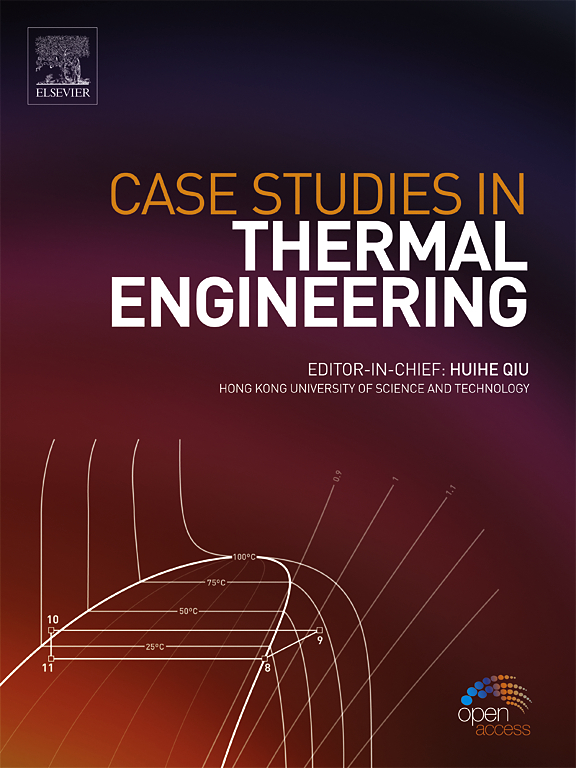Impacts of novel calotropis gigantea seed biodiesel usage as a fuel substitute along with various metal-oxide nanoparticles on the DICI engine characteristics
IF 6.4
2区 工程技术
Q1 THERMODYNAMICS
引用次数: 0
Abstract
Calotropis gigantea, commonly known as Indian milkweed, is a prevalent plant in Asia. It typically thrives in open and unused areas, often considered a weed. This plant produces flowers and fruits consistently throughout the year, exhibiting a continuous flowering and fruiting cycle. This research investigated the viability of Calotropis gigantea seed oil as a potential source intended for biodiesel manufacturing. The oil was obtained from Calotropis gigantea seeds using hexane extraction in the Soxhlet apparatus. The seeds were determined to contain 33.3 wt% of oil content. The process of biodiesel production involved conducting a transesterification reaction. Further, the produced biodiesel was blended with pure diesel and three different nanoparticles, Titanium dioxide (TiO2), Chromium oxide (Cr2O3), and Silicon dioxide (SiO2), to evaluate combustion performance, and emission characteristics of a single-cylinder diesel engine under various load conditions. Incorporating Cr2O3 nanoparticles into the CGSB20 biodiesel blend yielded significant improvements in BTE, coupled with BSFC reduction. Specifically, in the CGSB20 + Cr2O3 fuel mixture, BTE increased notably by 31.2 %, reaching a value of 0.33 g/kWh for BSFC. Similarly, for the CGSB20 + SiO2 and CGSB20 + TiO2 blends, BTE experienced enhancements of 29.2 % and 28.1 %, respectively, while BSFC values were lowered to 0.37 and 0.4 g/kWh. Furthermore, the unchanging dispersal of nanoparticles within the CGSB20 blend exhibited extraordinary cylinder pressure and HRR values, reaching 77 bar and 34.2 J/CA, respectively. The CGSB20+ Cr2O3 blend yielded favorable emissions outcomes. Specifically, CO, NOx, UHC, and smoke emissions were approximately 4.5 g/kWh, 725 ppm, 0.11 g/kWh, and 23.6 %, respectively.
将新型金盏花种子生物柴油与各种金属氧化物纳米颗粒一起用作燃料替代品对 DICI 发动机特性的影响
印度乳草(Calotropis gigantea)俗称印度乳草,是亚洲的一种常见植物。它通常生长在空旷和无人使用的地方,常被视为杂草。这种植物一年四季开花结果,开花结果周期持续不断。本研究调查了千层塔种子油作为生物柴油生产潜在原料的可行性。在索氏提取器中使用正己烷萃取从千层塔种子中获得了油。经测定,种子含油量为 33.3%。生物柴油的生产过程包括进行酯交换反应。然后,将生产的生物柴油与纯柴油和三种不同的纳米颗粒(二氧化钛 (TiO2)、氧化铬 (Cr2O3) 和二氧化硅 (SiO2))混合,以评估单缸柴油发动机在各种负荷条件下的燃烧性能和排放特性。在 CGSB20 生物柴油混合物中加入 Cr2O3 纳米粒子可显著提高 BTE,同时降低 BSFC。具体而言,在 CGSB20 + Cr2O3 燃料混合物中,BTE 显著提高了 31.2%,BSFC 值达到 0.33 g/kWh。同样,在 CGSB20 + SiO2 和 CGSB20 + TiO2 混合燃料中,BTE 分别提高了 29.2% 和 28.1%,而 BSFC 值则降低到 0.37 和 0.4 克/千瓦时。此外,纳米颗粒在 CGSB20 混合燃料中的不变分散表现出非凡的气缸压力和 HRR 值,分别达到 77 bar 和 34.2 J/CA。CGSB20+ Cr2O3 混合物产生了良好的排放结果。具体而言,CO、NOx、UHC 和烟雾排放量分别约为 4.5 克/千瓦时、725 ppm、0.11 克/千瓦时和 23.6%。
本文章由计算机程序翻译,如有差异,请以英文原文为准。
求助全文
约1分钟内获得全文
求助全文
来源期刊

Case Studies in Thermal Engineering
Chemical Engineering-Fluid Flow and Transfer Processes
CiteScore
8.60
自引率
11.80%
发文量
812
审稿时长
76 days
期刊介绍:
Case Studies in Thermal Engineering provides a forum for the rapid publication of short, structured Case Studies in Thermal Engineering and related Short Communications. It provides an essential compendium of case studies for researchers and practitioners in the field of thermal engineering and others who are interested in aspects of thermal engineering cases that could affect other engineering processes. The journal not only publishes new and novel case studies, but also provides a forum for the publication of high quality descriptions of classic thermal engineering problems. The scope of the journal includes case studies of thermal engineering problems in components, devices and systems using existing experimental and numerical techniques in the areas of mechanical, aerospace, chemical, medical, thermal management for electronics, heat exchangers, regeneration, solar thermal energy, thermal storage, building energy conservation, and power generation. Case studies of thermal problems in other areas will also be considered.
 求助内容:
求助内容: 应助结果提醒方式:
应助结果提醒方式:


